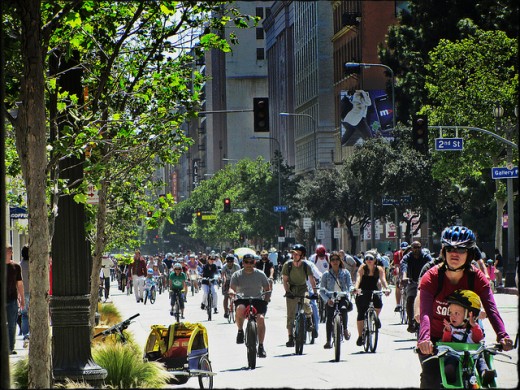 Los Angeles hosts community bike rides modeled after Bogoto, Colombia’s ciclovia events. Now San Diego is following their lead. | Photo Courtesy of Flickr
Los Angeles hosts community bike rides modeled after Bogoto, Colombia’s ciclovia events. Now San Diego is following their lead. | Photo Courtesy of Flickr
Mayor Bob Filner wants to make San Diego the bicycling capital of the nation but he admits he’ll need to sell the idea to most residents first.
That’s why he’s planning CicloSDias, a 5.2 mile-bicycle ride through the city from Logan Heights to City Heights. Come Aug. 18, Filner plans to shutter the area to car traffic to raise awareness of the benefits of cycling and walking. He hopes to host many similar events, though he hasn’t said how often he’ll host them.
As he campaigned for mayor, Filner promised to create the street fair as part of his larger goal of making San Diego more bikeable and walkable.
Filner’s idea isn’t a new one. He’s borrowed the concept, best known as ciclovia, from Bogota, Colombia. The city has long hosted weekly community bike rides on Sundays. Los Angeles and other U.S. cities now host similar rides.
Filner thinks the events will give San Diegans a greater understanding of bicyclists and their concerns.
But the concept of shutting out cars hints at Filner’s larger challenge: San Diego’s streets aren’t truly bike-friendly unless the cars disappear.
The mayor acknowledges as much.
“We are building up support for building up a bike infrastructure,” he said. “How do you bike from one part of the city to another? You can’t right now. That’s gonna cost money and it needs political support so we’re trying to build that up through these little smaller events.”
Still, support for improvements is growing.
Last week, the San Diego City Council approved a resolution to emphasize a symbolic commitment to develop more bike-friendly infrastructure at intersections and unsafe roadways across the city.
And late last month, Filner and others celebrated the opening of the city’s fourth bike corral in Hillcrest.
At the Feb. 25 press conference, Filner promised bicycle enthusiasts something more: “We’re gonna have a whole infrastructure that ties together this city from south to north, from east to west, with adequate biking,” he said. “It’s great for our psyche, it’s great for our bodies, it’s great for our souls, it’s great for our city.”
He hasn’t offered specifics on what that infrastructure might look like but the city’s bicycling advocates are optimistic.
Samantha Ollinger, executive director of BikeSD, said she introduced the ciclovia concept to Filner early in his mayoral campaign. He’s talked about it ever since.
She believes the new mayor could usher in bold changes in how car-centric San Diegans view cyclists.
“I knew for a very long time that unless the mayor came on strongly this was not going to go anywhere,” she said.
Andy Hanshaw, executive director of the San Diego County Bicycle Coalition, said he’s excited to see San Diego join a larger contingent of cities with ciclovia events.
Both Hanshaw and Ollinger’s group, as well as a handful of others, have met multiple times with Ed Clancy, the new manager of the city’s bicycle initiatives. Clancy, who served as Filner’s campaign manager in his run for mayor, is a longtime cyclist.
That the mayor has hired someone to handle such efforts shows the mayor’s commitment, Hanshaw said.
It’s relatively easy to create a new event but it’s much more challenging to come up with the funding and public support necessary to make infrastructure changes.
Council President Todd Gloria is familiar with those roadblocks.
Gloria, who represents mid-city neighborhoods that many bike activists call home, said he actually proposed a ciclovia event more than two years ago. It never materialized.
And in his first term, it took more than two years to add arrows, known as sharrows, to some city streets to indicate that motorists need to share their lane with bicyclists.
The city has since added the bike corrals and is expected to unveil a bike-sharing program this summer. (For more details on the program, check out this post.)
Gloria believes the new mayor’s interest and the recent City Council support bode well for bicyclists but emphasized that supporters must be prepared to explain why improved infrastructure will benefit all San Diegans and why it’s worth the cost.
“It’s going to take a lot of will to do that,” he said.
